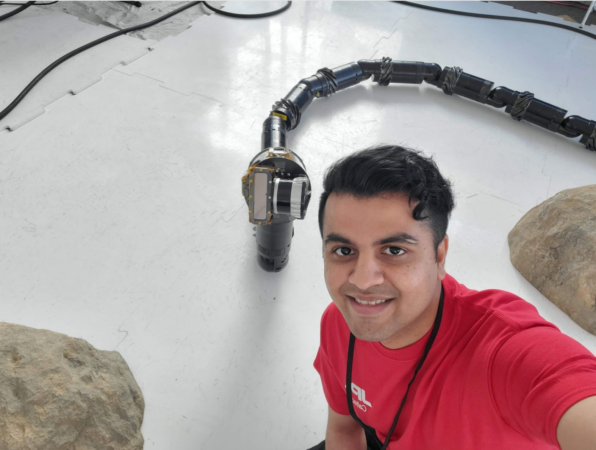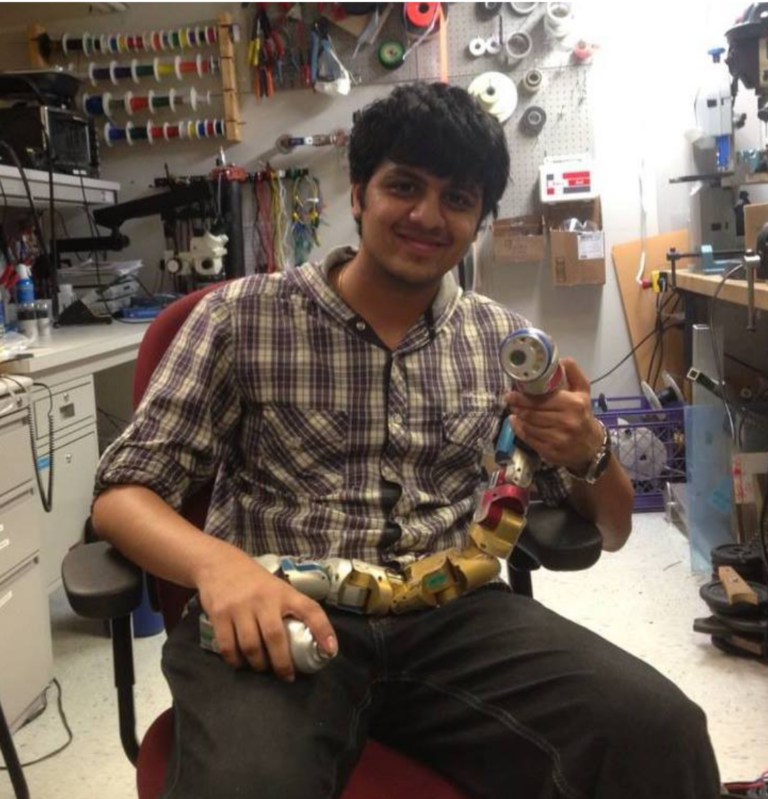Alumni Spotlight with Rohan Thakker
by Edward Terry (MRSD 2018) and Lekha Mohan (MRSD 2016)
The MRSD newsletter includes an Alumni Spotlight segment to highlight the exceptional achievements of alumni, which can inspire past, present and future students about what is possible with the education we receive in the hallowed wings of Newell-Simon Hall.
A*. Non-convex optimization. The sparse rewards problem in reinforcement learning. These terms read like an MRSD curriculum, but they are also concepts which come up when talking about people, purpose and persistence with the subject of this edition’s Alumni Spotlight: Rohan Thakker from the Class of 2016.
Meet Rohan
Working at NASA’s Jet Propulsion Laboratory in Pasadena, CA since graduating from MRSD, Rohan has been a major figure in the development of life-seeking snake robots inspired by the idea of a mission to Saturn’s icy moon Enceladus. He is the Autonomy Lead for the EELS project (Exobiology Extant Life Surveyor), a role which traces its roots to seeds of interest and inspiration planted many years prior.

The dawn of a robotics engineer
In the course of our interview with Rohan, two themes emerged: the value of long-term, strategic thinking, and persistence and the willingness to experiment. As an avid reader of Isaac Asimov as a kid, Rohan dreamed of a world with abundant resources, in which robots attend to our every need. As a high school student, he defied the convention of the day, preferring to learn how things work from first principles, even if it meant slipping in grades – he was in the bottom 20% of his class in 8th grade. He credits Rukmani Ma’am as a teacher who entertained all his deep questions, which changed his perspective on the purpose of education. Moving to undergrad, a desire to combine mechanical engineering, electrical engineering and computer science made robotics an inevitable choice, culminating in a placement at VNIT Nagpur, an early adopter of robotics as a standalone field of study. With the support of professors such as Shetal Ma’am, Padole Sir and Bhurchandi Sir, he started a robotics lab, which now counts more than 100 alumni in its ranks.

People who shaped his journey
The snake robots which are the current focus of Rohan’s professional life also owe their origin to this era, in particular an internship at IIT-Bombay with Professor Amarnath, along with Howie Choset and Matt Travers at CMU. With a foundation in research, Rohan applied to CMU’s MS Research program but was turned down, and was admitted to MRSD instead. Here, he credits the flexibility of the program and John Dolan’s willingness to support his desire to explore research threads, in addition to the systems focus of the program.
Two professors in particular boosted Rohan’s robotics skills: Koushil Sreenath, a controls professor who taught him “how to really do math”, and Sidd Srinivasa, who introduced the principle of “grounded research”. As a full-stack roboticist, Sidd modeled the practice of unifying the traditionally separate disciplines of perception, planning and manipulation, to do whatever it took to accomplish the task of making a personal home assistant robot.
The MRSD Era
Rohan’s experience in MRSD brought together the contrasting and complementary mindsets of research and systems integration in robotics. “Developing a new technology is sort of like A*. There is some forward search and a heuristic to tell you this is useful, directing your search. The exploration-like mindset of researchers, where you don’t necessarily know where an idea will apply, is the heuristic, and the requirements-driven model-based approach such as what we learn from Dimi, is the forward search. When you have a backward heuristic and a forward search at the same time, it makes you more efficient”.
Rohan goes on to talk about two styles of work. One is like a convex optimization problem, where the outcome is guaranteed if you just keep at it long enough – the equivalent of steady daily effort. The other is like a nonconvex version, where it is more important to have a fresh perspective on a problem to select a good starting point, which will lead you to the best solution. For Rohan, the best way to access this is to make time for hobbies such as working out, hiking, camping and paddleboarding.
Over the moon at JPL
Several years ago, Kalind Carpenter, a JPL Robotics colleague, was sitting at the desk across from Rohan. They often discussed the tantalizing findings of NASA’s Cassini, a probe that had surveyed Saturn and its moons. The spacecraft had observed vapor plumes emanating from cracks in Enceladus’ surface that planetary scientists believe could lead to a giant ocean under thick layers of ice. Where there is water, there is life. With Cassini’s findings, Enceladus became one of the most promising places in the solar system to potentially find life. However, a robotic mission to uncover this mystery could not rely on the same incremental steps that had served prior Mars missions, some argued. Sending an imaging probe to Enceladus, then a lander, then a rover, then a robot custom-made for the surveyed terrain, would take generations, given the ~10-year transit time to the moon. Kalind’s brief? To make a robot sufficiently mobile, reconfigurable and intelligent to traverse a snow field, descend into a thermal vent and emerge in the ocean below, collecting data which might point to the presence of life. But what would that robot look like?
Rohan argued for the same form as that of the model sitting on his desk: a snake robot.
Fast-forward to 2024, when the EELS team has returned from a successful experiment in Canada, with the 4.5m long, 100kg robot they have crafted from scratch. It was able to demonstrate sidewinding over soft snow, detecting an opening in a glacier, and one version of the robot descended 1.5m into it, all without human intervention or prior knowledge of the environment. The findings have just been published in Science Robotics.
Grit, Grind and Go
It took many “painful sleepless nights” (much more frequent than even in MRSD, according to Rohan) to solve a laundry list of technical problems. With the research now underway, Rohan says, “The biggest risk was ‘Can we even do this? Is it theoretically possible with the sensing and actuation available today?’”.
In a break from conventional autonomous mobile robots, this project called for tightly-integrated perception, planning and state estimation, given the uncertainty in the geometry and traction of the terrain. Just as humans can feel their way out of a dark room, the EELS robot can slow down and rely on lower-level sensory inputs to navigate, while increasing its distance from potential hazards in the environment. As for how to descend uneven, jagged crevasse walls, the key insight was to frame it as an inside-out grasping problem. In the same way as a human picks up a cellphone with enough fingertip compliance to conform to its shape, enough force to obtain sufficient friction, and in the right places to obtain a stable grasp, so too can this robot apply forces to a crevasse wall.
What is his “Why”?
Working on deep space missions, which can take decades to yield results, demands an unusual level of intrinsic motivation. Rohan’s early exposure to the work of Isaac Asimov brought about a mindset of the importance of long-term decision making. This has allowed him to persevere in this project, despite the lack of immediate rewards, both financial and technical.
A project of this scale, however, demands a level of collective persistence that Rohan gives some insight into for us. “The main challenge as a Lead is to align your team. You want to ask each person what their goals are – for some it’s writing papers, for others it’s getting into grad school, for others it’s building systems and getting visibility. My responsibility is to solve a constrained optimization problem where meeting the objectives of a project is the constraint, not the goal. It is most important to put people first.” In light of that, how to keep people motivated even when it seems impossible? He continues, “At some point ambition seems like insanity when you have deadlines and field tests coming up. You don’t succeed by imposing a timeline but by inspiring your team to be ambitious. As a lead you have to keep motivating them and showing them that the impossible is possible. You have to keep daring.”
This mindset was honed during MRSD where often the task felt impossible. In something we can all relate to, the solidarity of his classmates kept the dream alive. He recalls moments at 2am in a conference room in NSH, when “we knew we were screwed and yet we just played music and kept on working on the assignment”.
Hardships and Lessons
Moving to the US from India brought its own set of challenges. For example, in the throes of the final semester, with the hardest courses and an active job search, Rohan had to return to India to be with his father in his ailing health. And even after having been offered a job at JPL, his wife’s US visa status was not assured – while it was granted, his commitment to her above all else would have made it a clear decision to remain in India with her if it had not been granted.
Rohan plots out his life in three phases: individual learning, generating impact and giving back to people. His ultimate dream is to create innovators. He says “I will be more proud of the people that have a successful life from whatever motivation I was able to give than any particular career achievement. “Don’t pick the project. Pick the people. The way we do robotics changes. It was different from two decades ago and will be different in five years. Find the right people who are shaping the change. The project you think is important right now is noisy.” It certainly doesn’t hurt, however, to pick a compelling project, but, for this, the ideal is to “work on something that you can do 24 hours a day, 7 days a week if you weren’t paid for it. Work should be your passion.”
Rohan embodies the ethos of the MRSD program: to achieve excellence through creativity and persistence in a field which at the frontier of society’s progress. His parting advice? The JPL motto turned personal mantra: “Dare Mighty Things.”
